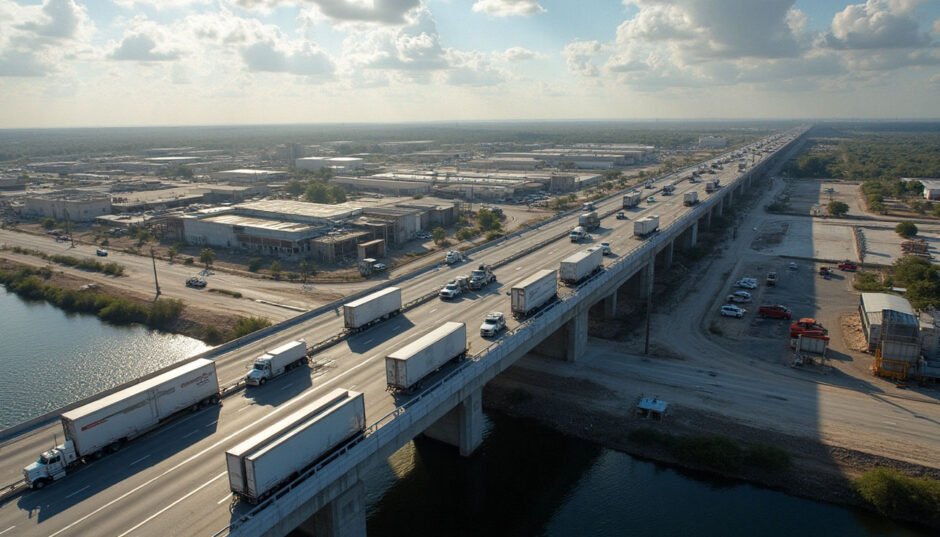. This bipartisan legislation leverages past achievements that secured presidential permits for four major international bridge projects in South Texas.
Communities along international boundaries depend heavily on border infrastructure that drives their economic growth through trade, business, and tourism. The legislation’s scope extends beyond specific Texas counties to cover all U.S.-Mexico and U.S.-Canada borders. State Department’s role would focus solely on foreign policy interests instead of environmental reviews. Laredo stands as a prime example of this significance and maintains its position as the #1 Port of Entry in the United States.
Cruz and Lujan introduce bipartisan bill to modernize border infrastructure
U.S. Senators Ted Cruz (R-Texas) and Ben Ray Luján (D-N.M.) have introduced the International Bridge and Port of Entry Modernization Act. This legislation aims to tackle ongoing infrastructure challenges at America’s borders.
What the International Bridge and Port of Entry Modernization Act proposes
The bipartisan bill streamlines the presidential permitting process for international bridges and land ports of entry. This legislation creates a faster path to approval. The bill’s scope extends beyond previous measures to cover all international land ports of entry along both the U.S.-Mexico and U.S.-Canada borders.
The act’s key provisions add the word “sole” before “basis” to make it clear that the State Department should evaluate permit applications based purely on America’s foreign policy interests. The legislation also blocks future administrations from using environmental documents in the presidential permit decision-making process, including those created under the National Environmental Policy Act.
How the bill builds on previous legislation from Cruz
Senator Cruz points out that this new legislation expands his previous successful efforts. “This bill builds on and expands our success in securing presidential permits for four major international bridge projects in South Texas by streamlining the approval process for all future international bridges along the Texas–Mexico border,” Cruz stated in a news release.
December 2023’s National Defense Authorization Act incorporated earlier legislation that created simplified permitting processes for international bridges in Eagle Pass, Laredo, and Brownsville. The State Department received a 60-day window to make permit recommendations to the president, with another 60-day presidential decision period.
Why bipartisan support is key to its momentum
Cruz and Luján’s collaborative effort shows a dedication to improving trade infrastructure across regional and political boundaries. Representative Tony Gonzales (TX-23) has introduced companion legislation in the House, and Representative Henry Cuellar (TX-28) joined as an original cosponsor.
Laredo Mayor Dr. Victor Treviño highlighted the importance of this teamwork: “Their bipartisan partnership reflects a strong commitment to strengthening trade along both our southern and northern borders”.
Multiple stakeholders have endorsed the bill, including the City of Laredo, Texas Association of Business, American Trucking Association, and the Texas International Produce Association. This widespread support boosts the legislation’s chances of passing. Senator Cruz strongly urges his colleagues “to pass this bill so it can be sent to the President for signature”.
Bill streamlines presidential permit process for international bridges
Presidential permits for international bridges require complex bureaucratic procedures that delay vital infrastructure projects. The International Bridge and Port of Entry Modernization Act, championed by Senators Cruz and Lujan, changes this process through targeted reforms.
What changes in the permitting process
The legislation requires the State Department to base recommendations solely on whether an international bridge serves U.S. foreign policy interests. This change narrows the scope of factors that affect permit decisions. The bill sets strict timelines that give the State Department 60 days to submit recommendations to the president, who then has 60 days to approve or deny applications.
The bill specifically prohibits National Environmental Policy Act (NEPA) documents from the presidential permit decision-making process. Notwithstanding that, NEPA review will still happen before construction or expansion begins, which helps maintain environmental oversight at the right stages.
Which agencies lose or gain authority
The Secretary of State receives all applications for presidential permits under Executive Order 13867 of April 10, 2019. The Bureau of Western Hemisphere Affairs handles most applications for facilities at Canadian and Mexican borders. Other agencies manage specific categories like petroleum pipelines, electrical transmission lines, natural gas pipelines, and submarine cables.
The Cruz-Lujan bill deepens the State Department’s role in evaluating foreign policy interests but removes its power to consider environmental factors. These changes reduce duplicate oversight that slows down vital infrastructure development.
How the bill affects both U.S.-Mexico and U.S.-Canada borders
Texas border needs sparked the original idea, but the legislation now covers all international land ports of entry along both U.S.-Mexico and U.S.-Canada borders. This coverage represents a major expansion from earlier legislation that applied to just three Texas counties.
Border communities benefit from ports of entry and international bridges through increased trade, business, and tourism. The optimized permitting process will affect all future international bridges along both borders and encourage economic growth while building stronger relationships with Canada and Mexico. Communities throughout northern and southern border regions will benefit from faster infrastructure development.
Local leaders and trade groups back the cruz and lujan bill
Border community leaders now champion the International Bridge and Port of Entry Modernization Act. They see its power to fix long-standing infrastructure problems.
Support from Laredo and other border cities
Laredo Mayor Dr. Victor Treviño strongly backs the Cruz and Lujan bill. He calls it “a critical step toward modernizing the development and expansion of cross-border infrastructure”. His support shows how vital this is for communities at the heart of international trade. Laredo remains the top port of entry in the United States. Senator Cruz’s work to simplify the permitting process earned him Laredo’s key to the city in October 2024. The City of Laredo has put its full support behind the legislation.
Statements from business and trade associations
The Cruz and Lujan bill has got support beyond city halls. Major industry groups like the Texas Association of Business, American Trucking Association, and Texas International Produce Association now back the legislation.
Texas Association of Business’s President and CEO Glenn Hamer highlighted the bill’s value: “No state is more impacted by international trade than Texas, and our entire business community relies on robust, efficient cross-border commerce to maintain access to global markets”. He also called it “the most important trade policy since the negotiation of USMCA”.
Why local economies depend on faster permitting
City permits often involve complex, expensive, and time-consuming steps that block development. Border communities feel these bureaucratic delays affect their economic growth directly.
Quick permitting helps the economy by:
- Boosting trade, business, and tourism in border areas
- Cutting costs linked to paperwork and administrative delays
- Helping small businesses stay financially healthy
This simplified approach brings speed and reliability to the presidential permitting process—something Laredo and similar communities see as crucial.
Bill removes environmental review requirements from future permits
The Cruz and Lujan bill stands out for its environmental provisions that change infrastructure project reviews. These changes target requirements that have made projects take longer than needed.
What environmental documents are excluded
The International Bridge and Port of Entry Modernization Act clearly stops future administrations from reviewing environmental documents during presidential permit decisions. This rule targets materials created under the National Environmental Policy Act (NEPA). NEPA requires federal agencies to check environmental effects before starting projects. The bill makes it clear that the State Department should base permit decisions solely on foreign policy interests. NEPA requirements still apply to any new international bridge or port of entry before construction or expansion starts.
Why this provision is controversial
Environmental groups see this exemption as dangerous. Earthjustice and similar organizations worry that bypassing environmental laws puts ecosystems and communities at risk. NEPA remains the life-blood of environmental law. It requires reviews for projects that involve federal participation, permits, or funding. These reviews have protected against harmful development. Cameron Walkup from Earthjustice warned that bypassing such laws could “cause further harm to border communities and ecosystems”. The Department of Homeland Security recently set a precedent by skipping 29 environmental laws to speed up border wall construction.
How this could affect future infrastructure projects
Border infrastructure development might move faster without environmental reviews at the permitting stage. A recent Supreme Court decision has already narrowed environmental review scope. The court said NEPA only needs agencies to look at direct environmental effects of current projects. Environmental impact statements don’t need to cover effects of separate projects. The Cruz-Lujan bill, combined with this legal backdrop, lets agencies take a narrower view of infrastructure effects. Border communities will see faster project approvals but might get a less detailed environmental review during the original permitting stage[184].
Conclusion
The International Bridge and Port of Entry Modernization Act marks a major change in the approval process for border infrastructure projects. What started as a solution for Texas border needs now covers all international land ports of entry on both northern and southern borders. Senators Cruz and Luján have created a bill that tackles the delays from bureaucracy while you retain control at key stages.
These changes will help border communities thrive. Places like Laredo, which serve as major trade hubs, depend on the quickest way to move goods across borders. Both parties support this effort, which shows how important it is to upgrade infrastructure, whatever your political views.
On top of that, the legislation draws clear lines about who has authority. The State Department keeps its role in checking foreign policy interests but faces limits on environmental factors during the presidential permit process. This helps cut duplicate reviews without dropping environmental checks before construction starts.
Without doubt, leaving environmental documents out of the permitting process raises debates. Critics worry about what it all means for ecology, while supporters point out that NEPA rules still apply before building begins. This approach tries to balance both economic and environmental needs.
The Cruz-Luján bill offers real solutions to real problems through fixed timelines, clear authority, and optimized processes. Local leaders, municipalities, and trade associations back this legislation because it addresses their community’s actual needs. While success depends on how it’s put into action, the framework paves the way to upgrade vital border infrastructure with proper safeguards in place.
FAQs
Q1. What is the main purpose of the Cruz-Lujan bill? The bill aims to streamline the presidential permit process for international bridges and ports of entry along both the U.S.-Mexico and U.S.-Canada borders, reducing wait times and modernizing border infrastructure.
Q2. How does the bill change the current permitting process? It requires the State Department to make recommendations based solely on foreign policy interests, establishes firm timelines for decisions, and prohibits consideration of certain environmental documents during the presidential permit process.
Q3. Who supports this legislation? The bill has garnered support from local leaders in border communities, such as the Mayor of Laredo, as well as business and trade associations including the Texas Association of Business and American Trucking Association.
Q4. Will environmental concerns be completely ignored under this bill? No, while the bill excludes environmental reviews from the presidential permit process, NEPA requirements will still apply before actual construction or expansion of any new international bridge or port of entry begins.
Q5. How might this bill impact border economies? The streamlined permitting process is expected to support trade, business, and tourism in border communities by reducing administrative delays and costs associated with infrastructure development, potentially boosting local economies.










